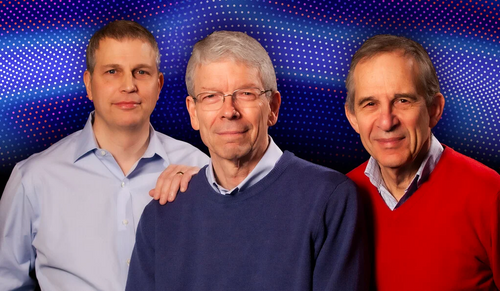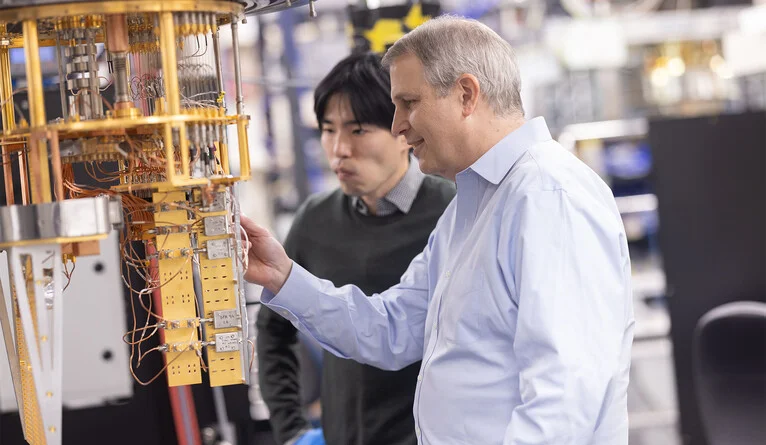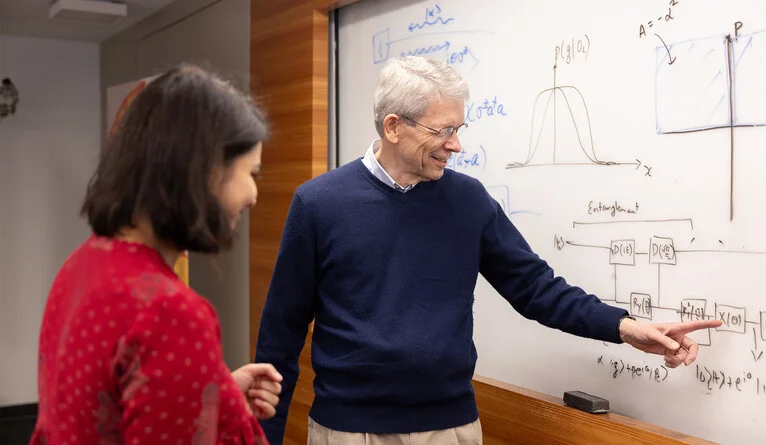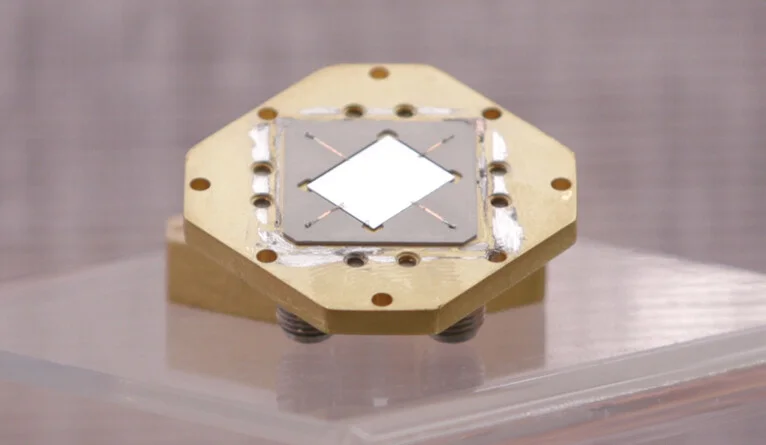
Yale’s Robert Schoelkopf, Michel Devoret, and Steven Girvin reflect on their trailblazing approach to quantum computing research.
By Jim Shelton
Yale’s quest to build the world’s first, fully useful quantum computer is also the story of a small-town kid’s obsession with short-wave radios, a Parisian’s fond boyhood memories of America, and a high school student from the New York suburbs who soaked up Saturday morning science programs at Yale’s Becton Center.
It is the story of three physicists — Robert Schoelkopf, Michel Devoret, and Steven Girvin — who converged at Yale and helped shape the way scientists worldwide approach the emerging field of quantum computing. Together, they and their Yale colleagues have imagined and built the scientific infrastructure for a new generation of technology, and elements of these discoveries now inform the research being done in labs around the world and most of the quantum computing products now in development.
This week, local and international colleagues are gathering on campus for a three-day conference to commemorate the 20th anniversary of the Yale scientists’ first published studies in what would be called Circuit QED (which stands for quantum electrodynamics), their trailblazing approach to quantum computing. Their approach has generated hundreds of academic papers and been cited by other researchers more than 100,000 times.
It has also helped make Yale a seedbed for tech industry talent in quantum computing, with graduate students and postdoctoral researchers moving on to positions at IBM, Google, and Silicon Valley start-ups, and at academic institutions around the globe.
And Schoelkopf, Devoret, and Girvin, who will play starring roles in this week’s conference, have been at the center of it all. All three have joint appointments at the Yale School of Engineering & Applied Science (SEAS) and Yale’s Faculty of Arts and Sciences (FAS).
Their vision? They wanted to create the “architecture” for a superconducting electrical circuit that harnesses the most curious features of quantum physics, such as the way quantum particles exist in multiple states at once (a phenomenon known as “superposition”) and the way these particles can become inextricably linked even when they are physically separated (described as “entanglement”). In this system, electrical signals propagating through the circuit would play the role of particles.
In doing so, it holds the promise of helping deliver historic advances in medicine, clean energy, and chemical engineering in a fraction of the time currently needed, not to mention providing revolutionary benefits in cybersecurity, traffic control, and artificial intelligence.
“Usually in physics, we think of our contributions to society as being indirect,” said Schoelkopf, Sterling Professor of Applied Physics at Yale School of Engineering & Applied Science with a secondary appointment in Physics in Yale’s Faculty of Arts and Sciences, and at age 59, the youngest of the trio. “You might be able to change the lives of your grandchildren. But this work offers a real opportunity to change things within our own lifetime.”
Introducing Circuit QED
Of the trio of Yale scientists at the forefront of this pioneering work, Schoelkopf was the first to join the university faculty, arriving as a postdoctoral researcher in 1995. Within three years he was an associate professor. Before coming to New Haven, he’d been a radio astronomer at Caltech, building sophisticated detectors to measure microwaves for space missions.
Schoelkopf was already familiar with Yale. As a high school student in Westchester County, New York, he used to travel to Yale’s Becton Center, the very building where he would later push the frontiers of quantum science, for weekend science programs.

“The one I remember most vividly was a demonstration of low-temperature physics, back in 1981,” Schoelkopf recalled. “That was my introduction to Yale and the spark for my interest in this kind of science.”
Girvin, now 73, was teaching at Indiana University when he first visited Yale in 2000 for a scientific colloquium. A theorist, he was studying the Quantum Hall effect, which involves the relationship of voltage, electrical current, and magnetic fields across an electrical conductor.
He had been fascinated by shortwave radios since he was a kid growing up in Brant Lake, New York, a hamlet in the Adirondacks. At the time, he’d hang antennas from tall trees, hoping to snag a faint radio signal from some faraway place — excellent training for envisioning quantum circuits decades later.

During his visit to Yale, Girvin introduced himself to a young researcher — Schoelkopf — who had recently developed the Radio Frequency Single-Electron Transistor, or RF-SET, a transistor so fast and sensitive that it changed the way one could count individual electrons as they passed through a circuit.
They began to talk shop. In a matter of minutes, Schoelkopf and Girvin were outlining on a blackboard what would become Yale’s new approach to reading bits of quantum information — called “qubits” — in a superconducting quantum computer.
Circuit QED would combine qubits with microwave photons (particles of electromagnetic radiation) in a physical device. Up to that point, no one had used microwaves as the vehicle to corral quantum data. But Schoelkopf saw that working with microwaves would make it easier, and less expensive, to engineer a quantum computer chip. Why? Because a massive manufacturing base already existed for the cell phone industry.
“Within 20 minutes we laid out the whole picture of what we could do together,” Girvin, who is now Yale’s Eugene Higgins Professor of Physics in the Faculty of Arts and Sciences (with a secondary appointment in Applied Physics at SEAS), recalled. “A few months after that, I moved over to Yale and completely switched what I was working on to something I hadn’t even heard of two years earlier.”
Of course, none of this theoretical work would mean anything without a specially designed, superconducting qubit that would work in the “circuit” Schoelkopf and Girvin envisioned.
The qubit guru
Qubits are often described as artificial atoms, but they’re actually much bigger than atoms. They’re about a millimeter long, in fact.
Scientists design qubits to have distinct properties and perform specific tasks, based on their environment. In the case of Circuit QED, the process would require a qubit that could “talk” to microwaves and also be able to hold onto its quantum information long enough to complete its portion of a calculation.
For Girvin and Schoelkopf, the first person who came to mind to design this qubit was a physicist in France, Michel Devoret, who had recently constructed a qubit with a much longer life than previous qubits. Unfortunately, no one at Yale thought they had a chance of luring Devoret away from Paris.
But they were wrong.
Devoret, now 70, had done some of the seminal work on artificial atom design, work he started in the lab of John Clarke at the University of California at Berkeley in the mid-1980s, before establishing his own lab at the French research facility CEA-Saclay. Devoret, along with his colleagues Daniel Esteve and Cristian Urbina, showed that key aspects of quantum physics could be viable in an electrical sense, operating within currents and voltages.
“We were making the first quantum bits, marrying the world of quantum physics to the world of electrical engineering,” Devoret said.
Then Devoret began hearing about new work that Yale researchers Douglas Stone and Dan Prober were doing in quantum mechanics. One of Prober’s postdoctoral associates — Schoelkopf — visited Devoret in France and told him about his progress in capturing and listening to microwaves. In 1999, Devoret, who had previously used microwaves for irradiating qubits but not listening to them, decided to take a sabbatical year at Yale.
“Rob and I set up a line of research in which we combined our expertise in quantum circuits and this new microwave technology,” he said. “It was the birth of Circuit QED.”
Persuading Devoret to leave France permanently was easier than expected: Devoret had lived in New Haven in 1966, when his father, a physician, had taken his own sabbatical at Yale School of Medicine. “It was wonderful,” Devoret, the Frederick W. Beinecke Professor of Applied Physics at SEAS (with a secondary appointment in Physics at FAS), said of that youthful experience. “It was a year in an exotic land, and I have great memories of life in the U.S. during this time.”

Devoret joined the Yale faculty in 2002, and he quickly became an integral part of the effort to lay the scientific groundwork for the birth of quantum computing using electrical circuits. Within two years, their first peer reviewed studies began appearing in major journals.
“We just immediately clicked,” Schoelkopf said. “You can be much smarter when you have smart people to talk to than you can be on your own, and we realized that.”
Putting qubits to work
One of the Yale team’s early landmark moments was the creation of the transmon qubit.
As it happened, the superconducting qubit that they introduced in 2007 was incredibly simple to build. “It’s just an antenna that communicates with microwaves,” Girvin said. “It looks like the kind of antennas I would hang between two trees, but this one is only one millimeter in size.”
The transmon qubit, however, had a decreased sensitivity to charge noise, which is an electrical field that can disrupt qubit performance. And over the next few years, it would become widely used by other quantum researchers worldwide.

Yale also led the way in improving the lifetime of qubits, which have increased roughly a million-fold (or by a factor of 10 every few years). This progression is now sometimes called Schoelkopf’s Law.
Next came the challenge of putting that qubit to work. Schoelkopf and Girvin’s labs already had shown how a single photon can be coherently coupled to a single superconducting qubit. This proved, just as the Yale team had theorized, that quantum actions can be performed in a microchip electrical circuit using microwaves.
They demonstrated, again in 2007, that they could send a photon signal on demand from a qubit onto wires and also that it was possible to transmit a signal to a second, distant qubit.
Then, in 2009, the team created the first rudimentary, solid-state quantum processor and, a year later, developed an amplifier to boost the signals of microwaves, achieving quantum entanglement of three solid-state qubits — crucial functional steps in establishing the potential power of quantum computing.
With these discoveries the Yale team was able to chip away at the overall goal of building a framework for Circuit QED. “It was like Whac-A-Mole,” Girvin remembered. “You fixed one problem and then moved to another.”
Meanwhile, Yale’s quantum team continued to expand. Weekly meetings, which in the beginning involved a handful of people in a fourth-floor alcove in Becton Hall, grew to more than a dozen people, then to more than two-dozen people, including senior and junior faculty, postdoctoral researchers, and graduate students.
Today, as many as 60 people gather for meetings in the sleek, renovated home of the Yale Quantum Institute, which was created in 2014 to enhance the university’s leadership in the field.
“Yale wasn’t afraid to hire people in the same research domain,” Devoret explained. “The bet was that everyone would collaborate. It wasn’t a competition — we reinforced each other.”
Error correction comes a-calling
By the early 2010s, Yale’s quantum researchers focused their efforts on one of the great hurdles facing quantum computing, the matter of correcting errors.
In standard computers, the data stored inside is largely insensitive to its surroundings. That is not the case for quantum computers. A slight change in a qubit’s environment — even the act of directly observing a qubit — can cause it to revert to one of the “classical” states of “0” or “1” rather than a quantum superposition of the two states. (Traditional computers do their work via bits of information that come in the form of “0”s and “1”s. In quantum computers, qubits exist as both a “0” and a “1” simultaneously.) When a qubit’s state reverts like this, it loses the data it was carrying. Even more frustrating, when one qubit reverts to a classic state, it can cause other qubits to do likewise, triggering a cascade of errors.
Again, Yale researchers doggedly pursued the problem.
In 2014, they showed for the first time the ability to track quantum errors as they occur, a key step in addressing the challenge.
“Ninety-nine percent of quantum computing will be correcting errors,” Schoelkopf said at the time. “Demonstrating error correction that actually works is the biggest remaining challenge for building a quantum computer.”
A year later, the Devoret and Schoelkopf labs discovered a new type of quantum “friction” that could lead to better storage of quantum memory, which would further advance error correction. In 2016, the Yale team created the first error correction system that was able to cross the “break even” point in preserving a qubit for longer than the lifetime of its constituent parts. It did this by fixing errors as they happened.
“This is the first error correction to actually detect and correct naturally occurring errors,” Schoelkopf said that summer. “It is just the beginning of using quantum error correction for real computing. Now we need to combine quantum error correction with actual computations.”
Quantum gates and universal entanglers
By the late-2010s, Yale researchers turned their attention to making their qubits more robust, expanding error correction, and exploring new ways that qubits can perform basic tasks necessary in a computer. For example, in 2018, Schoelkopf’s lab designed a system to keep errors in some qubits from “leaking” over to other qubits.
That same year, Yale demonstrated the ability to “teleport” a quantum gate. In computer science, a gate is a standard logic operation used to carry out steps between two bits of information within a computer program. But because entangled quantum bits can be located far apart, you need a gate that can operate in multiple places.
At the time, Schoelkopf described it as “a milestone toward quantum information processing using error-correctable qubits.”
And other discoveries kept coming. In 2019, Yale developed a “universal entangler”. Entanglement, as described earlier, is one of the key features that would give a quantum computer its computational power.
A two-cavity device created by Yale researchers used microwave photons to hold quantum information. A superconducting qubit, shaped like a “Y,” “talked” to both cavities to control and measure the photons inside them.
“It’s an incredibly cool gadget,” Girvin said.
Then, last year, Devoret led a team that improved on quantum error correction to more than double the lifetime of a qubit; the error-corrected qubit lasted 1.8 milliseconds — thousands of times longer than the first generation of superconducting qubits that had emerged just two decades earlier.
Taking it the last mile
While these innovations have put Yale at the forefront of quantum computing, the researchers recognize that much work remains before a truly useful quantum computer is ready.
The lifespan of a qubit needs to be longer — much longer. Error correction must be expanded and refined. Furthermore, every concept and feature Yale has pioneered will benefit from further simplification to be applied for practical use.
Yale’s quantum team is actively involved in each of those pursuits, Schoelkopf said.
In the meantime, Yale researchers continue to provide national leadership — and help create jobs in quantum technology.
In 2019, Yale startup firm Quantum Circuits Inc. — founded by Schoelkopf, Devoret, and Luigi Frunzio, a senior research scientist in applied physics — opened a 6,000 square foot facility in New Haven for the development and testing of quantum computing technology.
In 2020, Girvin was named director of the Co-design Center for Quantum Advantage, a new national center for quantum research led by Brookhaven National Laboratory. The new center features top researchers from two dozen institutions, including Devoret and Schoelkopf.
And last year, Yale partnered with the University of Connecticut to explore the idea of creating a “quantum corridor” in Connecticut. The plan is to bring together scientists, manufacturers, employment experts, business leaders, educators, and state and local officials to formulate a strategy for making the state a hub for jobs and innovations in the “quantum economy” — with Yale’s discoveries playing a key role.
Meanwhile, on campus, Yale has continued to invest in the growth of its quantum programs. The Physical Sciences and Engineering Building, to be constructed in the northern end of Science Hill, will be home to quantum computing, quantum engineering, and materials science initiatives, and is expected to be the largest building project in Yale’s history.
This week, the researchers behind Circuit QED paused for some reflection during a three-day conference on the Yale campus marking the 20-year anniversary of the first two studies in which Yale embarked on its quantum computing journey: “Strong coupling of a single photon to a superconducting qubit using circuit quantum electrodynamics,” published in the journal Nature in September 2004, and “Cavity quantum electrodynamics for superconducting electrical circuits: An architecture for quantum computation,” which appeared that June in the journal Physics Review A.
The conference, supported by the Yale Quantum Institute and the Sigma Xi Fund, will include remarks and presentations by quantum computing researchers from around the world, researchers from private industry — and from Schoelkopf, Devoret, and Girvin themselves.
On Wednesday, Girvin opened the first day of the conference (Watch his presentation). Devoret, who is now partly associated with the quantum computer effort at Google, opened the second day; Schoelkopf will give the final presentation on Friday.
Then it’s back to work.
“We’ve had a lot of good science over the years, but there are always exciting new ideas just ahead,” Schoelkopf said. “We want to take it the last mile and see the technology succeed in changing people’s lives.”
This article was originally published in Yale News on January 11, 2024.